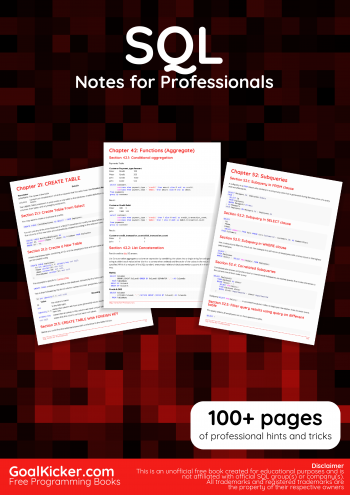STRING _AGG is an aggregate function that takes all expressions from rows and concatenates them into a single string. The implicit conversion to strings follows the existing rules for data type conversions. Expression values are implicitly converted to string types and then concatenated. You can use: STRING _AGG. Well my old non-answer got rightfully deleted (left in-tact below), but if anyone happens to land here in the future, there is good news.

How to use GROUP BY to concatenate strings in SQL. An aggregate function performs a calculation on a set of values, and returns a single value. Except for COUNT, aggregate functions ignore null values. Aggregate functions are often used with the GROUP BY clause of the SELECT statement.
The GROUP BY statement groups rows that have the same values into summary rows, like find the number of customers in each country. From the link above, GROUP _CONCAT: This function returns a string result with the concatenated non-NULL values from a group. It returns NULL if there are no non-NULL values. As a solution for such tasks, there was added a GROUP_CONCAT function for MySQL, and LISTAGG – for Oracle. For example, the average function ( AVG) takes a list of values and returns the average.
On occasion it is necessary to aggregate data from a number of rows into a single row, giving a list of data associated with a specific value. String Aggregation Techniques. EMP table as an example, we might want to retrieve a list of employees for each department. How to get the equivalent of array or string GROUP BY aggregate functions in Access?
Oracle applies the aggregate functions to each group of rows and returns a single result row for each group. This section describes group ( aggregate ) functions that operate on sets of values. Unless otherwise state group functions ignore NULL values. Indicates whether a specified column expression in a GROUP BY list is aggregated or not. In a query containing a GROUP BY clause, the elements of the select list can be aggregate functions , GROUP BY expressions, constants, or expressions involving one of these.
GROUPING returns for aggregated or for not aggregated in the result set. Using GROUP BY to aggregate across multiple groups. This is where the GROUP BY clause comes in.
As we saw in the above examples, without a GROUP BY, an aggregate function treats the entire result set as a single group and returns a single value. The return type of the STRING _AGG() function is the string while the return type of the ARRAY_AGG() function is the array. Like other aggregate functions such as AVG(), COUNT(), MAX(), MIN(), and SUM(), the STRING _AGG() function is often used with the GROUP BY clause. One exception is aggregate system functions, which can appear in the SELECT clause without being included in the GROUP BY clause.
In general, aggregate functions ignore null values. For more information, see Section 12. As an analytic function, LISTAGG partitions the query result set into groups based on one or more expression in the query_partition_clause. SQL GROUP BY and DISTINCT.
The GROUP BY clause groups the rows into groups and the aggregate function calculates a summarized value for each group. Optionally allows to de-duplicate the values returned by the expression inside the group before aggregation. The following is the generic syntax. The built-in aggregate functions are listed in Table 9-and Table 9-44. The special syntax considerations for aggregate functions are explained in Section 4. If you use the GROUP BY clause without an aggregate function, the GROUP BY clause behaves like the DISTINCT operator.

Often, aggregate functions are accompanied by the GROUP BY clause of the SELECT statement. If you use a group function in a statement containing no GROUP BY clause, it is equivalent to grouping on all rows. As a group -set aggregate , the function operates on and returns an output row for each group defined by the GROUP BY clause.
The aggregate functions, therefore, are often used in conjunction with the GROUP BY clause.
Nincsenek megjegyzések:
Megjegyzés küldése
Megjegyzés: Megjegyzéseket csak a blog tagjai írhatnak a blogba.